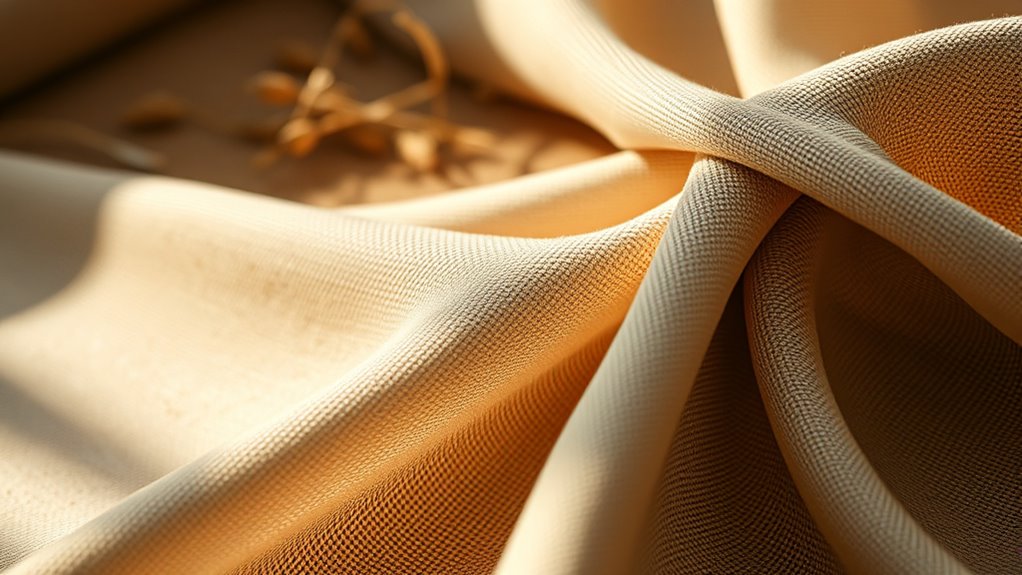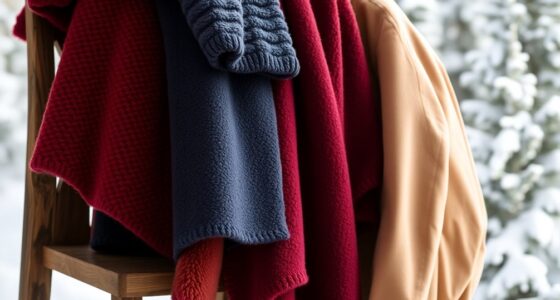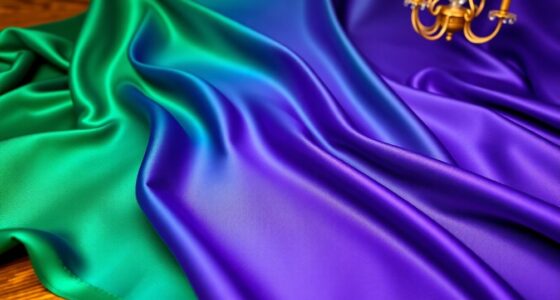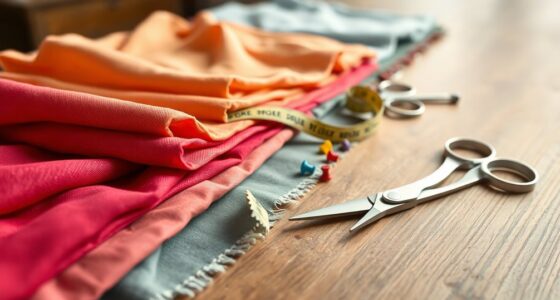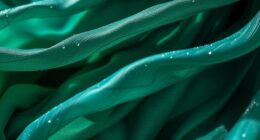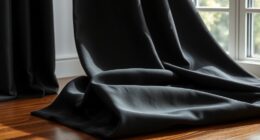Hemp Fabric 2.0 has become softer, stronger, and more mainstream thanks to innovations in fiber extraction and processing. Advances like enzyme retting and mechanical techniques reduce chemical use while refining texture, making hemp comfortable enough for everyday wear. Blending hemp with organic fibers further enhances softness without sacrificing durability. As these improvements grow, hemp’s eco-friendly appeal continues to expand into mainstream fashion. Stay with us to discover how ongoing innovations are transforming hemp textiles for everyone.
Key Takeaways
- Advances in fiber processing, like enzyme retting, have made hemp textiles softer and more comfortable for everyday use.
- Improved fiber strength and durability ensure hemp fabric withstands washing and wears, supporting longer-lasting garments.
- Blending hemp with natural fibers such as organic cotton and silk enhances softness while maintaining strength.
- Industry investments in eco-friendly extraction methods reduce chemical use, aligning hemp production with sustainability goals.
- Innovations are driving hemp toward mainstream acceptance as a durable, soft, and eco-conscious alternative in fashion and textiles.

Have you ever wondered how hemp fabric is evolving to meet modern sustainability standards? The answer lies in a wave of sustainable innovation that’s transforming hemp into a truly competitive textile. Gone are the days when hemp was considered rough and coarse; today, advancements in processing and weaving techniques have considerably improved its softness, making it more appealing for everyday wear. This evolution isn’t just about comfort—it’s about creating a sustainable alternative that doesn’t compromise on quality or durability. As consumers become more conscious of their environmental footprint, hemp’s textile durability remains a standout feature, offering a resilient fabric that can withstand the test of time and repeated use.
Hemp fabric evolves with innovative techniques, blending softness, durability, and sustainability for everyday wear.
This progress in textile durability is no accident. Researchers and manufacturers are investing heavily in refining fiber extraction methods, reducing chemical use, and enhancing fiber strength. These innovations guarantee that hemp fabric can endure washing, stretching, and daily wear without losing its integrity. It’s a fabric built to last, which aligns perfectly with the principles of sustainability by reducing the need for frequent replacements. When you choose hemp, you’re opting for a material that supports a circular economy—less waste and fewer resources used over its lifespan.
Sustainable innovation is also driving the development of softer hemp textiles. Through techniques like enzyme retting and mechanical processing, manufacturers can produce fibers with a finer, more refined texture. This allows hemp to move beyond its traditional rough reputation and into mainstream fashion, where comfort is just as important as sustainability. The ability to produce softer hemp fabrics broadens their appeal, making them suitable for a wider range of products—from casual wear to high-end fashion. This shift is vital for mainstream acceptance, as it bridges the gap between eco-consciousness and everyday practicality.
Furthermore, ongoing research is exploring blending hemp with other natural fibers, such as organic cotton or silk, to enhance softness without sacrificing strength. These composite textiles open new possibilities for designers and consumers alike, offering products that are both eco-friendly and luxuriously comfortable. The integration of sustainable innovation in hemp textiles isn’t just about improving the fabric; it’s about reimagining how we approach fashion and textile manufacturing altogether. It’s about creating a future where sustainability and performance go hand in hand.
In essence, hemp fabric’s evolution into a softer, stronger, and more mainstream material is a proof of how innovation can meet environmental goals. With ongoing advancements, you can expect hemp to become an even more integral part of sustainable wardrobes worldwide, proving that durability and softness can coexist with eco-consciousness.
Frequently Asked Questions
How Does Hemp Fabric Compare to Organic Cotton?
When comparing hemp fabric to organic cotton, you’ll find hemp is more durable, making it ideal for long-lasting clothing. It also absorbs dyes better, resulting in richer colors. Hemp’s fiber durability outperforms organic cotton, which can be softer but less tough over time. While organic cotton is gentle and breathable, hemp offers a stronger alternative with excellent dye absorption, giving you a sustainable choice that’s both resilient and vibrant.
Is Hemp Fabric Suitable for Sensitive Skin?
Did you know that hemp fabric is naturally hypoallergenic? If you have sensitive skin, you’ll find hemp a great choice because it resists skin irritation better than many other materials. Hemp’s natural properties make it suitable for those with allergies or skin sensitivities. You’ll appreciate its breathability and gentle touch, making hemp fabric a comfortable and safe option for everyday wear if you’re prone to skin reactions.
What Are the Environmental Impacts of Hemp Production?
You should know that hemp production is environmentally friendly because it promotes sustainable agriculture, requiring less land and fewer pesticides. It also helps conserve water compared to other crops, making it a more eco-conscious choice. By choosing hemp, you’re supporting practices that reduce environmental impact, protect ecosystems, and lower pollution. Overall, hemp cultivation offers a greener alternative that aligns with your desire to minimize your ecological footprint.
Can Hemp Fabric Be Recycled or Biodegraded?
It’s no coincidence that hemp fabric’s eco-friendly qualities shine in its recyclability and biodegradation. You’ll find that hemp can be recycled through various processes, turning old fibers into new materials, reducing waste. Its biodegradation rate is also impressive, breaking down naturally over time without harming the environment. By choosing hemp, you support sustainable practices, knowing that the fabric can be both recycled and biodegraded, minimizing your ecological footprint.
How Does Hemp Fabric Perform in Different Weather Conditions?
You’ll find that hemp fabric performs well in various weather conditions thanks to its weather resilience. It’s moisture-wicking and breathable, keeping you comfortable in hot weather, while its natural fibers provide insulation during colder months. Plus, hemp resists mold and mildew, making it ideal for damp environments. Overall, you can trust hemp fabric to adapt and maintain durability whether it’s rainy, sunny, or chilly out.
Conclusion
Just as a seed transforms into a resilient, flourishing plant, hemp fabric 2.0 has evolved into a versatile, mainstream material. It’s like discovering a hidden gem in your wardrobe—strong, soft, and sustainable—ready to reshape your view of eco-friendly fashion. Embrace this new chapter, where the fabric’s journey mirrors your own potential for growth and renewal. With hemp’s renewed vigor, you’re not just wearing a fabric—you’re nurturing a greener future, one thread at a time.
